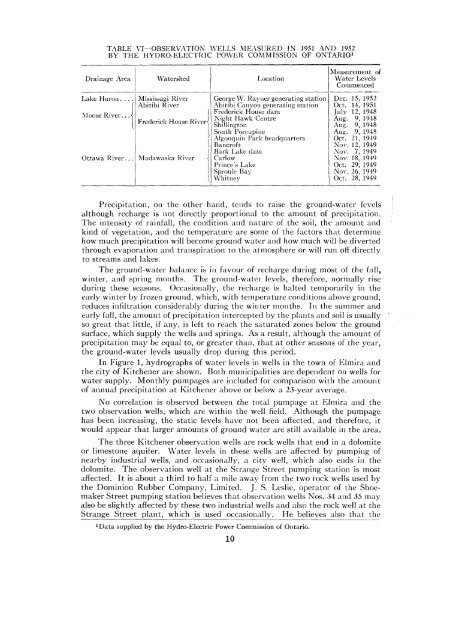B152 - Ground Water In Ontario, 1951 And 1952 - Geology Ontario
B152 - Ground Water In Ontario, 1951 And 1952 - Geology Ontario
B152 - Ground Water In Ontario, 1951 And 1952 - Geology Ontario
Create successful ePaper yourself
Turn your PDF publications into a flip-book with our unique Google optimized e-Paper software.
TABLE VI OBSERVATION WELLS MEASURED IN <strong>1951</strong> AND <strong>1952</strong><br />
BY THE HYDRO-ELECTRIC POWER COMMISSION OF ONTARIO 1<br />
Drainage Area<br />
<strong>Water</strong>shed<br />
Location<br />
Measurement of<br />
<strong>Water</strong> Levels<br />
Commenced<br />
Lake Huron . . .<br />
ḟ<br />
Moose River. . A<br />
Ottawa River. . .<br />
Mississagi River<br />
Abitibi River<br />
f<br />
Frederick House Riven<br />
\<br />
Madawaska River<br />
'<br />
George W. Rayner generating station<br />
Abitibi Canyon generating station<br />
Frederick House dam<br />
Night Hawk Centre<br />
Shillington<br />
South Porcupine<br />
Algonquin Park headquarters<br />
Bancroft<br />
Bark Lake dam<br />
Carlow<br />
Prince's Lake<br />
Sproule Bay<br />
Whitney<br />
Dec. 15, <strong>1952</strong><br />
Oct. 14, <strong>1951</strong><br />
July 12, 1948<br />
Aug. 9, 1948<br />
Aug. 9, 1948<br />
Aug. 9, 1948<br />
Oct. 21, 1949<br />
Nov. 12, 1949<br />
Nov. 7, 1949<br />
Nov. 18, 1949<br />
Oct. 29, 1949<br />
Nov. 26, 1949<br />
Oct. 28, 1949<br />
Precipitation, on the other hand, tends to raise the ground-water levels<br />
although recharge is not directly proportional to the amount of precipitation.<br />
The intensity of rainfall, the condition and nature of the soil, the amount and<br />
kind of vegetation, and the temperature are some of the factors that determine<br />
how much precipitation will become ground water and how much will be diverted<br />
through evaporation and transpiration to the atmosphere or will run off directly<br />
to streams and lakes.<br />
The ground-water balance is in favour of recharge during most of the fall,<br />
winter, and spring months. The ground-water levels, therefore, normally rise<br />
during these seasons. Occasionally, the recharge is halted temporarily in the<br />
early winter by frozen ground, which, with temperature conditions above ground,<br />
reduces infiltration considerably during the winter months. <strong>In</strong> the summer and<br />
early fall, the amount of precipitation intercepted by the plants and soil is usually<br />
so great that little, if any, is left to reach the saturated zones below the ground<br />
surface, which supply the wells and springs. As a result, although the amount of<br />
precipitation may be equal to, or greater than, that at other seasons of the year,<br />
the ground-water levels usually drop during this period.<br />
<strong>In</strong> Figure l, hydrographs of water levels in wells in the town of Elmira and<br />
the city of Kitchener are shown. Both municipalities are dependent on wells for<br />
water supply. Monthly pumpages are included for comparison with the amount<br />
of annual precipitation at Kitchener above or below a 23-year average.<br />
No correlation is observed between the total pumpage at Elmira and the<br />
two observation wells, which are within the well field. Although the pumpage<br />
has been increasing, the static levels have not been affected, and therefore, it<br />
would appear that larger amounts of ground water are still available in the area.<br />
The three Kitchener observation wells are rock wells that end in a dolomite<br />
or limestone aquifer. <strong>Water</strong> levels in these wells are affected by pumping of<br />
nearby industrial wells, and occasionally, a city well, which also ends in the<br />
dolomite. The observation well at the Strange Street pumping station is most<br />
affected. It is about a third to half a mile away from the two rock wells used by<br />
the Dominion Rubber Company, Limited. J. S. Leslie, operator of the Shoe<br />
maker Street pumping station believes that observation wells Nos. 34 and 35 may<br />
also be slightly affected by these two industrial wells and also the rock well at the<br />
Strange Street plant, which is used occasionally. He believes also that the<br />
J Data supplied by the Hydro-Electric Power Commission of <strong>Ontario</strong>.<br />
10

















